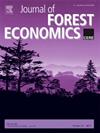肯尼亚森林生态系统服务的经济价值:对PES方案设计和参与式森林管理的启示
IF 0.7
4区 农林科学
Q3 ECONOMICS
引用次数: 9
摘要
森林生态系统服务对人类福祉以及经济的运作和增长至关重要。然而,尽管对这些服务的需求不断增长,但在制定公共政策时却很少给予适当的考虑。在发展中国家,当地社区对这些服务所附加的价值通常也不为人所知。以茂森林保护区为例,采用选择实验方法,采用有效设计准则对森林相邻群落的显著森林生态系统服务功能进行评价。利用条件logit模型、随机参数logit模型和带交互作用的随机参数logit模型对各生态系统服务的附加价值进行了估计。结果显示,家庭之间的偏好存在高度异质性,社区更倾向于保护项目,这些项目可以保证他们改善森林覆盖,减少洪水风险,提高水质和饮用水量,但如果选择一个中等野生动物种群的替代方案,则会遭受福利损失。这项研究的一个重要发现是,森林附近社区的利他主义本质,这一点由他们为防洪支付的高意愿所揭示,这表明他们不仅关心个人的利益,而且关心社会的福利。总体而言,我们发现森林生态系统服务的作用得到了更多的认可,森林邻近社区更倾向于保护,主要是由直接利用价值和非利用价值驱动的。在政策方面,这些资料构成了设计以市场为基础的奖励措施的基础,例如PES和参与性森林管理的推广、设计和实施。决策者还需要关注具有更高平均福利影响的政策选择,以深化社区对森林保护的参与,同时考虑到偏好的异质性,以确保公平。本文章由计算机程序翻译,如有差异,请以英文原文为准。
Economic Valuation of Forest Ecosystem Services in Kenya: Implication for Design of PES Schemes and Participatory Forest Management
Forest ecosystem services are critical for human well-being as well as functioning and growth of economies. However, despite the growing demand for these services, they are hardly given due consideration in public policy formulation. The values attached to these services by local communities are also generally unknown in developing countries. Using a case study of the Mau forest conservancy the study applied a choice experiment technique employing the efficient design criteria to value salient forest ecosystem services among forest adjacent communities. The values attached to various ecosystem services were estimated using the conditional logit, random parameter logit model and random parameter logit model with interactions. The results revealed high level of preference heterogeneity across households and that communities would prefer conservation programs that would guarantee them improved forest cover, reduced flood risk and high water quality and quantity for drinking but would experience a loss in welfare for choosing an alternative with medium wildlife population. One significant finding from the study is the altruistic nature of forest adjacent communities as revealed by the high willingness to pay for flood mitigation showing that they are not just concerned with the private benefits accruing to them but also the welfare of the society. Overall, we found that there is much appreciation for the role of forest ecosystem services and that forest adjacent communities are more pro conservation mainly motivated by the direct use and non-use values. In terms of policy, the information forms a basis for the design of market based incentives such as PES and the roll out, design and implementation of participatory forest management. Policy makers also need to focus on policy options with higher mean welfare impacts to deepen community involvement in forest conservation while taking into account the heterogeneity in preferences to ensure equity.
求助全文
通过发布文献求助,成功后即可免费获取论文全文。
去求助
来源期刊

Journal of Forest Economics
农林科学-林学
CiteScore
1.70
自引率
0.00%
发文量
16
审稿时长
>36 weeks
期刊介绍:
The journal covers all aspects of forest economics, and publishes scientific papers in subject areas such as the following:
forest management problems: economics of silviculture, forest regulation and operational activities, managerial economics;
forest industry analysis: economics of processing, industrial organization problems, demand and supply analysis, technological change, international trade of forest products;
multiple use of forests: valuation of non-market priced goods and services, cost-benefit analysis of environment and timber production, external effects of forestry and forest industry;
forest policy analysis: market and intervention failures, regulation of forest management, ownership, taxation;
land use and economic development: deforestation and land use problem, national resource accounting, contribution to national and regional income and employment.
forestry and climate change: using forestry to mitigate climate change, economic analysis of bioenergy, adaption of forestry to climate change.
 求助内容:
求助内容: 应助结果提醒方式:
应助结果提醒方式:


